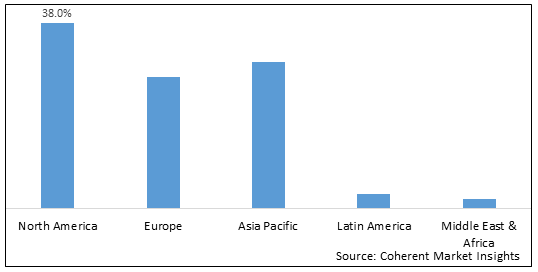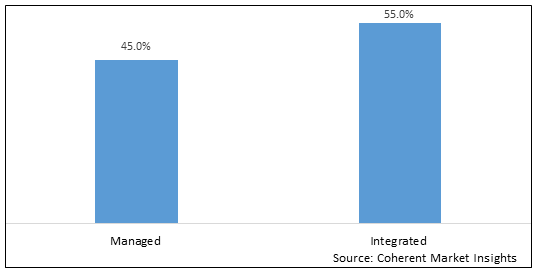The Global Smart Home as a Service market size was valued at US$ 11.3 Billion in 2023 and is anticipated to witness a compound annual growth rate (CAGR) of 12.11% from 2023 to 2030. Smart home as a service or also referred to as (SHaaS) is a type of service where instead of consumer, service provider selects, installs, maintains, upgrades, and programs smart home devices. Smart home as a service uses the subscription-based business models with monthly payment from consumers. Novel technologies are used in SHaaS including connected devices, sensors, cloud intelligence, and social media to combine a variety of important services into a simple-to-use app that allows service providers to make their consumers’ lives effortless and simple. There are three major aspects of smart home as a service namely intelligence, connectivity, and functionality where it can help the user to function properly.
Global Smart Home as a Service market: Regional Insights
North America is predicted to hold the greatest share of the worldwide smart home market. Some of the most significant market companies call it home, including Apple (US), Amazon (US), and Honeywell (US). There are various factors such as rising demand for dependable household energy management systems, higher gadget standards, increased levels of home security, and the growing popularity of the incorporation of smart gadgets such as standalone voice assistants, smartphones, and tablets in North America, homes are driving the demand for smart homes. The quantity of smart houses in North America, particularly the United States, has the highest rate of any region in the globe. As a result, the During the projected period, the market in this area is expected to rise at a stable rate.
Figure 1: Global Smart Home as a Service market Share (%), By Region, 2022

To learn more about this report, request a free sample copy
Global Smart Home as a Service market Drivers:
Rising usage of smartphone to drive the market growth
The penetration of tablets and smartphones is increasing all over the world in all age groups. Moreover, the adoption of smartphones is showing significant rise, especially in emerging countries such as India, Mexico, and Brazil among others. There has been a dramatical shift in penetration of smartphones in these countries. Several young adults are mainly contributing major share to the rise in adoption of smartphones. This in turn is expected to boost growth of the Global Smart Home as a Service market over the forecast period.
Increasing public concern over convenience, security, and safety
Smart homes are meticulously crafted to automate diverse household appliances and electronic devices through an embedded monitoring framework, thereby delivering convenience, efficiency, safety, and security to inhabitants. A unified interface oversees and regulates lighting, security, temperature, and audio/video setups. Emphasizing security, smart homes prioritize this aspect significantly, incorporating cutting-edge security systems capable of alerting homeowners about intrusions and facilitating room-specific surveillance even during their absence. Essential for safeguarding residential spaces, access control systems assume a pivotal role. The escalating employment of home automation and control systems in smart homes, owing to their advanced efficiency and sophistication, is effectively elevating security measures.
Global Smart Home as a Service market Opportunities:
Increasing popularity of mobile applications is expected to offer growth opportunities in the Global Smart Home as a Service market over the forecast period. With increasing popularity of mobile applications, companies are also deploying such mobile apps for delivering the content to employees. These applications allow marketing, sales, and other departments, to reduce the purchasing cycle and efficiently track interactions to bottom line results. For instance, Alibaba offers a mobile app allowing access to an online platform that consists global wholesale trade in any location. Thus, increasing popularity of mobile applications is likely to create growth opportunities in the global market.
Incorporating data connectivity into lighting controls
The diversity of products that are currently available, including dimmers, timers, occupancy sensors, daylight sensors, and relays, is evidence of the lighting control industry's recent growth. These products come with choices for standalone operation and slick interaction with home automation systems. Lighting control automation frequently needs external connection protocols. The development of models with integrated data connectivity, which do away with the need for external protocols and communication, is now being done by manufacturers of lighting control systems.
Global Smart Home as a Service market Restraint:
Issues regarding privacy and misuse of technology are expected to restrain the global smart home as service market growth over the forecast period
Concerns regarding data theft, data breach, and theft of personal information and data are expected to restrain growth of the market. Since the technology is extending to the most of the devices at home, there is a desperate need for a standardized security platform to minimize and avert the possible cyber-security-related risks. Moreover, tackling the risk of data collection via common connectivity needs to be addressed too. Hence, these factors are expected to restrain the global smart home as service market growth over the forecast period.
Smart Home as a Service Market Report Coverage
| Report Coverage | Details | ||
|---|---|---|---|
| Base Year: | 2022 | Market Size in 2023: | US$ 11.3 Bn |
| Historical Data for: | 2018 to 2021 | Forecast Period: | 2023 to 2030 |
| Forecast Period 2023 to 2030 CAGR: | 12.1% | 2030 Value Projection: | US$ 25.15 Bn |
| Geographies covered: |
|
||
| Segments covered: |
|
||
| Companies covered: |
Ingersoll-Rand plc (Nexia), Vivint, Inc., Protection One Alarm Monitoring, Inc., The ADT Corporation, Telus Communications, Frontpoint Security Solutions, AT&T Inc., Johnson Controls, Inc., Comcast Corporation, Charter Communications (TWC), and CenturyLink, Inc. |
||
| Growth Drivers: |
|
||
| Restraints & Challenges: |
|
||
More convenience-driven rather than necessity-driven market
Smart home provides convenience and advanced measures to operate various electronic products at home. These products are generally thought of as facilitating everyday activities. Solve your energy efficiency problem. There are some concerns related to smart home exclusivity Technology, for example when technology is perceived as a luxury that can only be purchased by certain individuals Additionally, many homeowners are still unaware of the benefits it offers These systems are excellent in terms of cost and energy savings. Buyers should also invest in additional tools Deploy complete home automation including displays, software, sensors and analytics solutions.
Global Smart Home as a Service market Trends:
Emerging opportunities for tech and insurance companies
Both insurance and tech companies have major growth opportunities in the market. For instance, companies, forming partnerships and packages with tech companies are essential for growth. Since tech companies are introducing novel products and innovations, such partnerships are major opportunities for insurance companies to be a part of the global smart home as a service market and influence it deeply. For instance, British Gas is in partnership with Axa Assistance offering bundled boiler covers and Allianz partnering with Panasonic to test Nest water leak detection devices. Similarly, John Lewis offered a discount on Nest smoke detectors with premium insurance.
New connectivity standard influencing eco-system
Major advancements in information technology and the emergence of high-speed internet connectivity standards such as 5G are major factors affecting the eco-system since they will be more intelligent and interconnected with minimal legacy. Moreover, high-speed internet standards such as 5G are expected to reduce costs while improving reliability. These new eco-systems will allow better utilization of data and will broaden the scope and benefits of behind-the-meter initiatives like data-driven customer engagement tools, specifically for analytics and to meet demand response.
Figure 2: Global Smart Home as a Service market Share (%), in terms of Value, By Services, 2022

To learn more about this report, request a free sample copy
Global Smart Home as a Service market Segmentation:
The Global Smart Home as a Service market report is segmented into Service and Solution
Based on Service, the market is segmented into Managed, and integrated services. Out of which, Integrated is expected to dominate the global market over the forecast period. Due to the rising demand and increased adoption of integrated services, the integrated service category is poised to experience consistent growth and maintain its predominant position throughout the projected period. Comparatively, the managed service sector is expected to command a smaller portion of the global smart home service market.
Segmented by Solution, the market encompasses Security and Access, Lighting and Window, Audio-Visual and Entertainment, Energy Management and Climate, and Integrated Solutions. Among these, the integrated solution segment holds a dominant stance. Following closely, the Security and Access solution sector is anticipated to secure the second-largest market share. Notably, the Audio-Visual and Entertainment segment is projected to outpace other segments in terms of growth rate.
Global Smart Home as a Service market: Key Developments
Global Smart Home as a Service market: Key Companies Insights
The Global Smart Home as a Service market is highly competitive. This is attributed to continuous launch of new technologies due to ongoing R &D and efforts by value chain participants. Moreover, key players are adopting various business growth strategies in order to expand their presence on regional as well as global basis. Key players operating in the global smart home as a service market are Ingersoll-Rand plc (Nexia), Vivint, Inc., Protection One Alarm Monitoring, Inc., The ADT Corporation, Telus Communications, Frontpoint Security Solutions, AT&T Inc., Johnson Controls, Inc., Comcast Corporation, Charter Communications (TWC), and CenturyLink, Inc.
*Definition: A smart home allows homeowners to control appliances, thermostats, lights, and other devices remotely using a smartphone or tablet through an internet connection. Smart homes can be set up through wireless or hardwired systems.
Frequently Asked Questions
Joining thousands of companies around the world committed to making the Excellent Business Solutions.
View All Our Clients